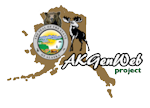



|
|
MT. KATMAI ERUPTION - 06 JUN 1912
|
|
On June 6-9th, 1912, the most spectacular Alaskan eruption in recorded history and one of the two largest eruptions in the world in the twentieth century (the other being Mount Pinatubo in 1991) resulted in the formation of a large summit caldera at Katmai volcano. The over 60-hour-long eruption actually took place at a vent about 6 mi (10 km) to the west of Mount Katmai (now marked by Novarupta dome) from which an estimated 30–35 km≥ of ash flows and tephra were ejected rather than at Mount Katmai itself. Based on geochemical and structural relationships, it has been suggested that magma drained from beneath Katmai Volcano to Novarupta via the plumbing system beneath Trident Volcano. The withdrawal of magma beneath Katmai resulted in the collapse of the summit area, forming the caldera. Following the subsidence, a small dacitic lava dome known as Horseshoe Island was emplaced on the floor of the caldera; this is the only juvenile material erupted from Katmai caldera during the historical eruption. It was visible at the time of the expedition in 1916, but has since been submerged by the crater lake. Still, the eruption from Katmai had a VEI of 3, and possibly involved phreatic eruptions.[2]
Approximately 12–15 km≥ of magma was vented during the 1912 eruption
producing about 35 km≥ of tephra. An estimated 11–15 km≥ of ash flow
tuff traveled 12 miles (20 km) northwest covering an area of about 120
km≤ in what subsequently came to be known as the Valley of Ten Thousand
Smokes. The ash flow tuff produced in the 1912 eruption is made up of a
silica-rich volcanic rock called rhyolite. In fact, this is the only
major Quaternary eruption of rhyolite to have occurred in Alaska.
Maximum thickness of the ashflow is estimated to be about 800 feet (240
m). About 20 km≥ of airfall tephra was carried east and southeast with a
minor lobe to the north covering 77,000 km≤ with more than 1 in (2.5 cm)
of ash. Light ash fall was reported as far away as the Puget Sound
region 1,500 mi (2,400 km) away. Extremely fine ash blown into the
stratosphere remained in suspension as aerosols for months and caused
spectacular red sunsets in many parts of the world.
|


Kodiak Island Borough AKGenWeb Copyright This page was last updated 12/26/2023 |